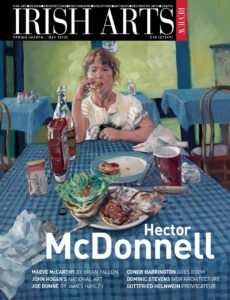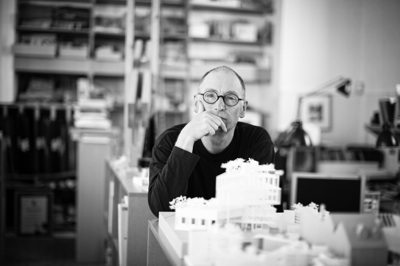

William Laffan previews the exhibition ‘Ireland: Crossroads of Art and Design 1690-1840′ which opens at the Art Institute of Chicago in March
In October 1645 Giovanni Battista Rinuccini, Innocent X’s nuncio, arrived at Kenmare, County Kerry, on his ill-fated mission to guide the Irish Confederacy. In addition to 2,000 muskets, 400 brace of pistols, 2,000 pike heads, 20,000 pounds of gunpowder and large amounts of cash, a member of the papal retinue, Giovanni Alamanno di Stefano, brought a small painting of the Crucifixion by Lucas Cranach, presumably for private devotion. Rinuccini’s mission was a disaster. Even for a Jesuit-educated canon lawyer the intricacies of the political situation and sheer duplicity of its multiple protagonists was overwhelming and on his return to Italy di Stefano wrote a lengthy inscription on the reverse of his Cranach panel detailing how the papal legates had ‘miraculously escaped the mouths of death, undermined by those damned, English, Scottish and Hibernian heretics’ (see Christie’s sale 1136 July 2013, Lot 18 for catalogue entry on this work). Exactly a century later in a quite different cultural exchange between Ireland and Rome, the wealthy brewer Joseph Leeson (soon to be ennobled as 1st Earl of Milltown) was in Italy shopping for paintings, furniture and sculpture to fill his house, then rising, at Russborough, County Wicklow. In Rome he purchased a series of paintings of subject matter notably at variance with the orthodoxy of the Reformed Church, reflecting instead the Mariology and martyrology of the older faith: A Virgin Annunciate, after Reni, a St Agatha, after Guercino, and perhaps least consistent with the low nature of the 18th-century Church of Ireland, a Mystic Marriage of St Catherine by Agostino Masucci and a portrait of Pope Benedict XIII.
The irony of the Protestant Leesons’ avid consumption of such overtly Catholic, Counter-Reformation iconographies is only surpassed by the earlier papal mission’s choice of religious imagery. Bringing to Ireland the work of a (quite literally) Saxon artist and friend of Luther was a distinctly unpropitious omen for a papal legate. However, for all their differences of purpose and intent, the two instances serve to highlight the flow of works of art into Ireland and the sometimes unexpected frissons that an Irish context can impart. This is the subject of a major exhibition at the Art Institute of Chicago, ‘Ireland: Crossroads of Art and Design 1690-1840′ which examines Irish art and design in the century and a half from the Battle of the Boyne to the eve of the Famine and sets the production and consumption of art and artefacts firmly within European and North Atlantic contexts.
Just as wealthy patrons like the Leesons imported shiploads of trove from Italy – and the gentry and middling classes indulged in occasional purchases on shopping trips to London – since the late 19th century the contents of many of the great houses of Ireland have been largely dispersed. With only two exceptions, all of the more than 300 objects included in the show have been drawn from North American collections serving to show how objects have continued their journeys, often accruing additional associations or resonances as they went. One of Leeson’s acquisitions in Rome, a 2nd-century marble statue of the Venus Genetrix has subsequently travelled all the way from Blessington to the Californian sun of the Getty Villa (Fig 1). Contrasting with its classical perfection – but undergoing a similar change of association and context – is a powerfully expressionist ‘penal’ crucifix from Lough Derg which had until recently been catalogued as a Native-American artefact (Fig 4). Both utterly different pieces of sculpture are included in the Chicago show which explores objects, whether made by Irish hands or not, which formed the visual backdrop to Irish life in the long 18th century.
Often national identities are imprecise and the exhibition attempts a nuanced approach to the occasionally complex genesis of works of art in an age of increasing mobility
As well as taking this very neutral stance on authorship – as opposed to ultimately reductive attempts to assert an Irish school – the exhibition, curated by Christopher Monkhouse with the assistance of Leslie Fitzpatrick, defines Irish visual culture widely in terms of genre or typology and in so doing fills several lacunae in the 5-volumes of Art and Architecture of Ireland recently published by the Royal Irish Academy and Yale University Press, which omitted discussion of most aspects of Irish design before the 20th century. This had the distorting effect of neglecting the very arts in which Ireland excelled, bookbinding, for example, or glass making. The Chicago exhibition makes up for these surprising absences and, in addition to well-known masterpieces by James Barry (Fig 2) and Robert Healy, the show includes ample selections of Irish glass, silver, ceramics, textiles (appropriately as 2015 is the Year of Irish Design) while there are also sections on Irish furniture, pastels, mezzotints, miniatures and even musical instruments.
When an exhibition of ‘Master European Paintings’ from the National Gallery of Ireland travelled to Boston and the Art Institute of Chicago in 1992, Irish artists were conspicuous by their absence. This exhibition fills this gap for an American audience with works by Susannah Drury, Charles Jervas, James Latham, Thomas Frye, Nathaniel Hone, George Barret, Hugh Douglas Hamilton, Thomas Roberts, Jonathan Fisher and Adam Buck. But the show also acknowledges the inherent difficulty in singling out the Irish component of the material world of an island colonized by its nearest neighbour, with porous borders, a government that actively encouraged the settlement of craftsmen from continental Europe, and patrons who often preferred the work of non-native artists. So, to reflect the realities of patronage, portraits commissioned by Irish sitters from William Hogarth, Pompeo Batoni, Gilbert Stuart, Thomas Laurence and even Jacques-Louis David are included, as are paintings purchased by Irish patrons from European masters. Also on show is the work of French-Huguenot silversmiths or cabinetmakers like John Kirkhoffer of German extraction. Often national identities are imprecise and the exhibition attempts a nuanced approach to the occasionally complex genesis of works of art in an age of increasing mobility of craftsmen and transmission of motifs and styles. Richard Castle architect of Leinster House, Powerscourt and Russborough grew up in Saxony of Anglo-Dutch-Jewish ancestry. His mother was born in Bombay. A fine tapestry now in the Metropolitan Museum in New York was woven in 1738 by Jan Van Beaver who presented it to the Weaver’s Hall in Dublin’s Coombe. Van Beaver took his likeness of George II from an engraving after a 1716 portrait by Sir Godfrey Kneller; the frame, which the weavers themselves commissioned, is, however, of Irish manufacture and probably by John Houghton (the tasseled ropes are an Irish trademark). There is some irony that this strange amalgam of a portrait – by a Flemish weaver, after a German-born painter, of a German-speaking English king- seems a peculiarly Irish object.
Collecting – and the Grand Tour – trade, taste, marketing, fashion and how they influenced consumption are all themes of the Chicago exhibition. Dedicated sections in both exhibition, and catalogue, reflect on travel and tourism; Dublin as centre of power, law and learning; the country house as site of consumption, and the harp a symbol at once contested and unifying. Inevitably some individuals loom large, Lord Charlemont, for example, and his patronage of, and quarrel with, Piranesi and happier collaborations with Sir William Chambers and William Hogarth. While Charlemont promoted international neoclassicism in Ireland he was not immune to the charms of the East and was one of a hundred or so Irish patrons to commission an armorial dinner, or tea service from China. The chain of the Order of Saint Patrick on a piece of Qianlong porcelain (Fig 6) is a telling sign of the incipient globalization in the production and distribution of luxury goods. Another cross-fertilization of Ireland and the East, here mediated through French rococo, is a silver dish ring (a particularly Irish form) made by Charles Townsend in Dublin in 1772 with chinoiserie decoration (Fig 5). As in England and France, the taste for chinoiserie permeated many of the applied arts and is exemplified by the imitation of Chinese designs on Dublin delftware; by rooms decorated with imported Chinese paper at Westport, County Mayo (c. 1780-90) and Caledon, County Tyrone (c. 1820-30); and less visibly (though for this very reason showing just how pervasive le go√ªt chinois had become) in the use of Chinese fretwork patterns on the service staircases of Dublin townhouses. However, objects from the East could do more than supply a decorative flourish. A Japanese suit of armour at the feet of Sir Neil O’Neill in a 1680 portrait by John Michael Wright seems to reference the persecution of Jesuit missionaries in Japan. O’Neill – who was to die ten years later from wounds suffered at the Boyne ‚Äî presents himself as a defender of his faith with the arms of its persecutors at his feet.
Collecting by grandees had a direct impact on artists back in Ireland. Both Charlemont and Leeson owned works by Claude Lorrain, as did the ducal Leinsters, who acquired the Coast Scene with Europa and the Bull (1634) through the 2nd Duke’s marriage to Emilia Olivia St George. This great Claude was recorded in 1795 as hanging in the James Wyatt-designed picture gallery at Leinster House (now the chamber of the Senate) and later in the Saloon at Carton. It is now in the Kimbell Art Museum in Fort Worth, but has been lent to Chicago to hang in the County House section of the exhibition where the Dutch tradition is represented by the magnificent landscape by Meindert Hobbema long at Newbridge, Country Dublin, and now in the National Gallery in Washington. Charlemont and the Leesons were known for the easy access they granted to their collections, especially to artists, and they and the Leinsters were active patrons of the Dublin group of landscape painters, notably George Barret and Thomas Roberts. These artists formed a distinctive and highly accomplished body of work, taking inspiration from great masters such as Claude and Hobbema, from the Irish landscape, and possibly, too, from a precocious adaptation of plein air painting. Canvases by Barret and Roberts hung in Leinster House alongside the Claude, and works by Rubens and Rembrandt, and at Russborough side by side with a Poussin. Roberts’ set of views of Carton (Fig 3), unfinished at his premature death in 1777, is one of the supreme achievements of Irish landscape painting, a field in which (as was recognized at the time) Ireland excelled. While certainly offering an American audience a flavour of Irish art and design, the exhibition goes further and instead of presenting it in hermetic isolation – as Irish art all too often is shown – recreates the self-confident hangs of Russborough and Leinster House with Roberts and Barret side-by-side with Claude and Hobbema with Hone, Latham and Jervas next to David and Batoni; and classical sculpture given equal billing with a humble penal cross.
‘Ireland: Crossroads of Art and Design 1690-1840′ the Art Institute of Chicago, 17 March – 7 June 2015.
William Laffan served as advisor to ‘Ireland: Crossroads of Art and Design 1690-1840′ and is co-editor of the accompanying catalogue.



